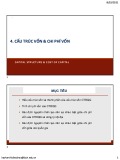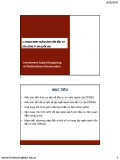International accounting Chapter 4: Merchandising Operations
LOGO
Chapter 4
MA. Nguyen Quoc Nhat
Learning Objectives
1. Describe and illustrate merchandising operations and
the two types of inventory systems
2. Account for the purchase of inventory using a perpetual
system
3. Account for the sale of inventory using a perpetual
system
4. Adjust and close the accounts of a merchandising
business
5. Prepare a merchandiser’s financial statements 6. Use gross profit percentage, inventory turnover, and
days in inventory to evaluate a business
7. Account for the sale of inventory using a periodic system 8. Prepare worksheets for a merchandiser
www.themegallery.com
Company Logo
Chapter ‘s content
4.1 What Are Merchandising Operations? 4.2 Accounting for Inventory in the Perpetual System 4.3 Adjusting and Closing the Accounts of a Merchandiser 4.4 Preparing a Merchandiser’s Financial Statements 4.5 Three Ratios for Decision Making
www.themegallery.com
Company Logo
MA. NguyenQuocNhat nhatnq.faa@gmail.com 1
International accounting Chapter 4: Merchandising Operations
4.1 What Are Merchandising Operations?
www.themegallery.com
Company Logo
4.1 What Are Merchandising Operations?
The operating cycle of a merchandiser is as follows : 1. It begins when the company purchases inventory from a vendor. 2. The company then sells the inventory to a customer. 3. Finally, the company collects cash from customers.
www.themegallery.com
Company Logo
4.1 What Are Merchandising Operations?
Inventory Systems:
There are two main types of inventory accounting systems: ● Periodic system ● Perpetual system
www.themegallery.com
Company Logo
MA. NguyenQuocNhat nhatnq.faa@gmail.com 2
International accounting Chapter 4: Merchandising Operations
4.1 What Are Merchandising Operations?
Inventory Systems:
There are two main types of inventory accounting systems: ● Periodic system - the business physically counts its inventory periodically to determine the quantities on hand ● Perpetual system - the number of inventory units and the dollar amounts are perpetually (constantly) updated.
www.themegallery.com
Company Logo
4.2 Accounting for Inventory in the Perpetual System
Purchase of Inventory Suppose Smart Touch buys $35,000 of inventory, returns $700 of the goods, and takes a 2% early payment discount. Smart Touch also pays $2,100 of freight in. The following summary shows Smart Touch’s net cost of this inventory. All amounts are assumed for this illustration.
www.themegallery.com
Company Logo
4.2 Accounting for Inventory in the Perpetual System
www.themegallery.com
Company Logo
MA. NguyenQuocNhat nhatnq.faa@gmail.com 3
International accounting Chapter 4: Merchandising Operations
4.2 Accounting for Inventory in the Perpetual System
Sale of Inventory Sales revenue (Sales): The amount a business earns from selling merchandise inventory. Cost of goods sold (COGS) (also known as Cost of sales or COS)is the cost of inventory that has been sold to customers. the merchandiser’s major expense
www.themegallery.com
Company Logo
4.2 Accounting for Inventory in the Perpetual System
Sale of Inventory A sales return: The customer may return goods to Smart Touch, asking for a refund or credit to the customer’s account. A sales allowance: Smart Touch may grant a sales allowance to entice the customer to accept non-standard goods. This allowance will reduce the future cash collected from the customer. A sales discount: If the customer pays within the discount period—under terms such as 2/10, n/30—Smart Touch collects the discounted amount. Freight out: Smart Touch may have to pay delivery expense to transport the goods to the buyer.
www.themegallery.com
Company Logo
4.3 Adjusting and Closing the Accounts of a Merchandiser
A merchandiser adjusts and closes accounts the same way a service entity does. If a worksheet is used, the trial balance is entered, and the worksheet is completed to determine net income or net loss
www.themegallery.com
Company Logo
MA. NguyenQuocNhat nhatnq.faa@gmail.com 4
International accounting Chapter 4: Merchandising Operations
4.3 Adjusting and Closing the Accounts of a Merchandiser Closing still means to zero out all accounts that aren’t on the balance sheet. All amounts are assumed for this illustration.
www.themegallery.com
Company Logo
4.4 Preparing a Merchandiser’s Financial Statements
Income Statement: The income statement begins with Sales, Cost of goods sold, and Gross profit. Then come the operating expenses, which are those expenses other than Cost of goods sold
www.themegallery.com
Company Logo
4.4 Preparing a Merchandiser’s Financial Statements
Balance sheet: For a merchandiser, the balance sheet is the same as for a service business, except merchandisers have an additional current asset, Inventory. Service businesses have no inventory.
www.themegallery.com
Company Logo
MA. NguyenQuocNhat nhatnq.faa@gmail.com 5
International accounting Chapter 4: Merchandising Operations
4.5 Three Ratios for Decision Making
The Gross Profit Percentage
www.themegallery.com
Company Logo
4.5 Three Ratios for Decision Making
The Rate of Inventory Turnover
www.themegallery.com
Company Logo
4.5 Three Ratios for Decision Making
Days in Inventory
www.themegallery.com
Company Logo
MA. NguyenQuocNhat nhatnq.faa@gmail.com 6
International accounting Chapter 4: Merchandising Operations
LOGO
www.themegallery.com
MA. NguyenQuocNhat nhatnq.faa@gmail.com 7


























